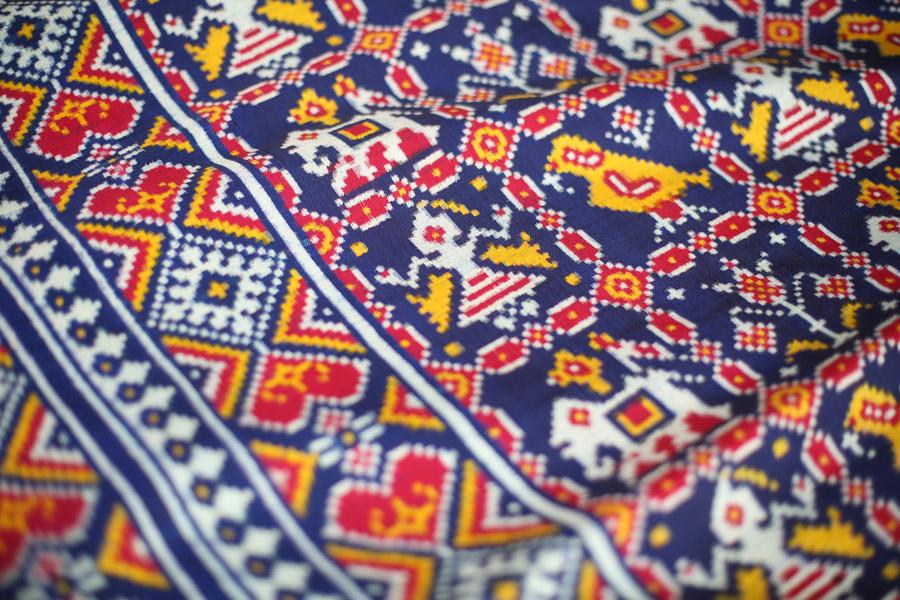From ancient trade ties to a fashion statement across 30 countries, Ikat is a really fascinating weave, which universally symbolizes wealth, power and prestige. A shared textile art especially between India and Indonesia.
A visually beautiful and artistic, textile dyeing and weaving technique involves specific computations that focus on mathematical symmetry – where every inch is calculated and connected.
The very term ikat is derived from Indonesian mengikat, meaning “to tie” – a reference to the distinctive technique used to create them. A complex, skill-intensive process of marking, tying and dyeing the design into the yarn. This process may be repeated multiple times to produce elaborate, multicolored patterns. When the dyeing is finished all the bindings are removed and the yarns are woven into cloth. The weaving process then reveals the rich and intricate patterns in the resulting fabric.
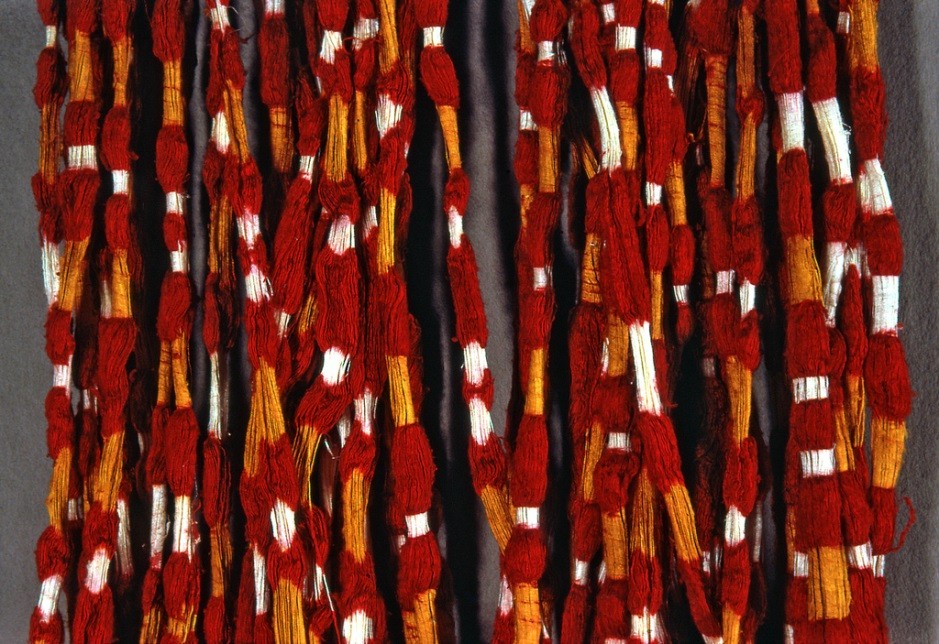
Although united by a common technique, ikat textiles are astonishingly diverse in their imagery, which ranges from bold geometric compositions to figurative patterns of striking visual and technical virtuosity. As the surface design is created in the yarns rather than on the finished cloth, in ikat both fabric faces are patterned.
It is an incredible feat of textile manufacturing process; an art form that, when conducted the traditional handwoven way to the most expert degree, can take between 1-2 years to complete.
This centuries old weaving process so tedious and painstaking that Ikat has been termed as ‘Poetry of the Loom’ yields a beautiful product with an intentional bleed that has a slightly blurry or fuzzy appearance. This characteristic blurriness” to the design of ikat textiles is a result of the extreme difficulty the weaver has lining up the dyed yarns so that the pattern comes out perfectly in the finished cloth. The blurriness can be reduced by using finer yarns or by the skill of the crafts person. Ikats with little blurriness, multiple colours and complicated patterns are more difficult to create and therefore often more expensive. However, the blurriness that is so characteristic of ikat is often prized by textile collectors.
History of Ikat
The ancient trade routes of Asia blur the Ikat origins history into one tapestry. Quite fitting, considering the fuzzy Ikat style.
Textile experts believe that the art evolved in various places in Indonesia and other South East Asian countries like Cambodia, Myanmar, Philippines, and Thailand. They have a long history of developing the ikat weaving style; each with a flavor of its own.
Ikat has been part of the Indonesian archipelago’s cultural history for millennia. Over time, different regions across Indonesia’s 17,000 islands perfected their own designs and production styles, which are still regionally represented today.
Ikat is not India’s indigenous textile, and is thought to have come to India long, long ago; because of its trade ties in the ancient times with China and Indonesia. In fact, the fine quality of ikat from India became so popular that at one point in history, ikat was taken as currency on the famous Silk Route in ancient times. The oldest surviving example of Ikat was an Indian Odishan style found in a Pharaohs tomb. It’s also proof of the longstanding trade between India and Egypt.
In India, it came to be developed as a prominent handloom textile art in three major regions – Andhra Pradesh/Telangana, Gujarat, and Odisha. Over the years, these three regions developed their own style of ikat weaving – each distinct in pattern and the way the yarn is dyed and used.
Types of Ikat
There are 3 styles of Ikat production. In order of difficulty, they are: Warp, Weft and Double Ikat.
Warp ikat
The Iban of Borneo, the Toba Batak’s of North Sumatra and cultures throughout Nusa Tenggara – from Flores to Sumba – have a strong Warp Ikat tradition.
In warp ikat it is only the warp yarns that are dyed using the ikat technique. The weft yarns are dyed a solid colour. The ikat pattern is clearly visible in the warp yarns wound onto the loom even before the weft is woven in. Warp ikat is, amongst others, produced in Indonesia; more specifically in Kalimantan, Sulawesi, and Sumatra by respectively the Dayaks, Torajans and Bataks.
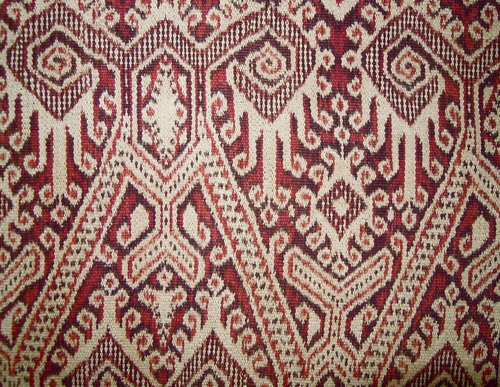
Weft Ikat
The Weft technique is well established in South Sumatra and Bali.
In weft ikat it is the weaving or weft yarn that carries the dyed patterns. Therefore, the pattern only appears as the weaving proceeds. Weft ikats are much slower to weave than warp ikat because the weft yarns must be carefully adjusted after each passing of the shuttle to maintain the clarity of the design.
In Thailand, weavers make silk sarongs depicting birds and complex geometrical designs in seven color weft ikat.
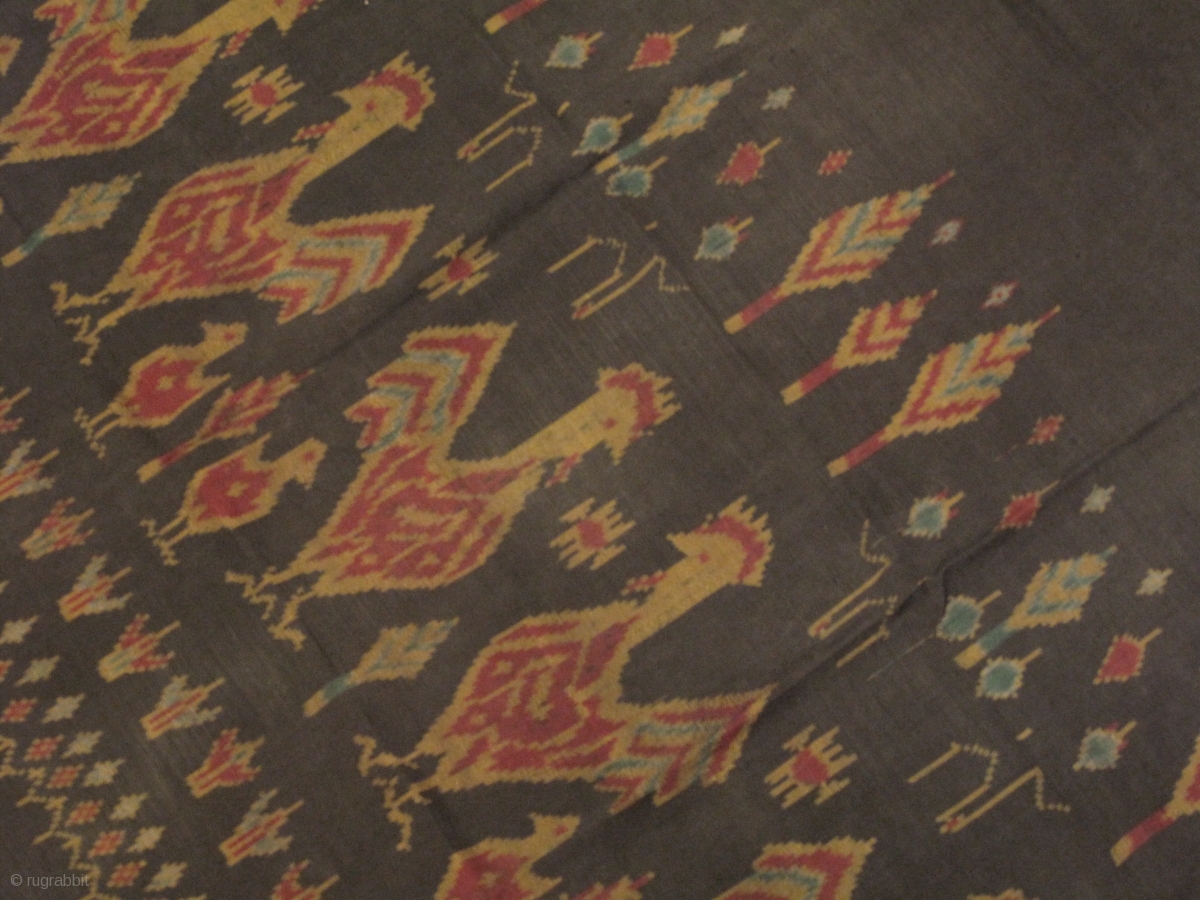
As the weft is commonly a continuous strand, aberrations or variation in coloration are cumulative. Some weft ikat traditions incorporate this affect into their aesthetic. Patterns become transformed by the weaving process into irregular and erratic designs.
Double ikat
Double Ikat is a technique in which both warp and the weft are resist-dyed prior to weaving. Obviously it is the most difficult to make and the most expensive. Double ikat is only produced in three countries: India, Japan and Indonesia.
The village Bali Aga, Tenganan, East Bali stands out in South East Asia as the spiritual home of the complicated Double Ikat process – which is an unrivaled skill for producing the patience-testing style of Geringsing Double ikat. The word Gringsing – Gring derived from the word meaning ‘sick’ and – Sing meant “no”, therefore Gringsing means to avoid pain. Geringsing are treasured as they are purported to have magical powers. Some of the Tenganan double ikat motifs are taken directly from the Indian patola tradition.
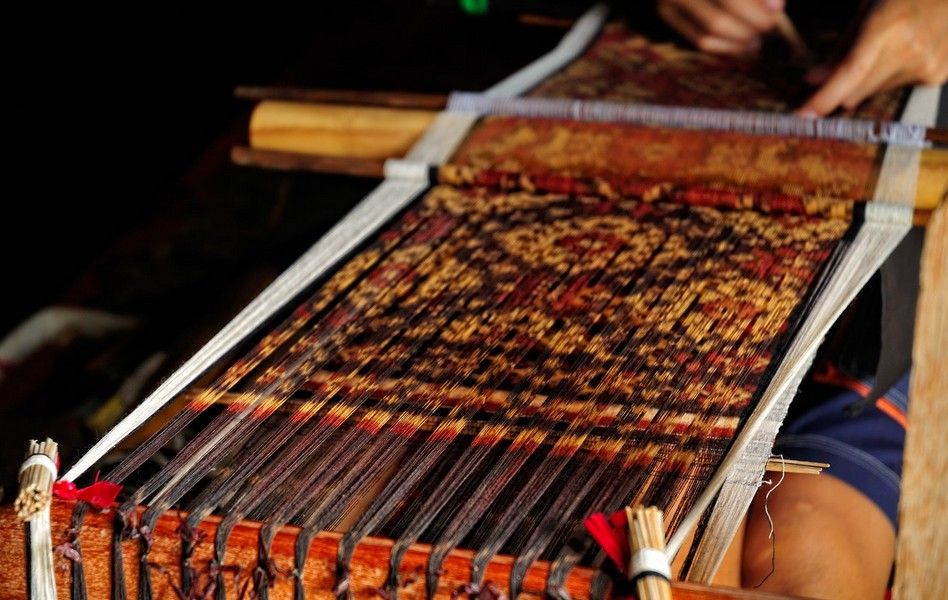
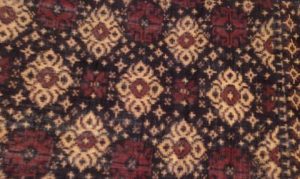
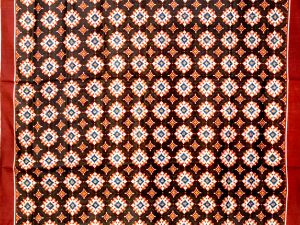
The double ikat made in Patan, Gujarat in India is the most complicated. Called “patola,” it is made using fine silk yarns and many colors. It may be patterned with a small motif that is repeated many times across the length of a six-meter sari. Sometimes the Patan double ikat is pictorial with no repeats across its length. That is, each small design element in each color was individually tied in the warp and weft yarns. It’s an extraordinary achievement in the textile arts.
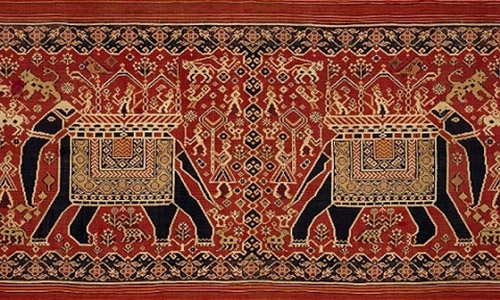
These much sought after textiles were traded by the Dutch East Indies company for exclusive spice trading rights with the sultanates of Indonesia. In India double ikat is also woven in Telangana and called ‘Telia Rumaal’. In Japan, double ikat is woven in the Okinawa islands where it is called Kasuri.
How to differentiate the various types of ikat
One quick way to determine real from faux is to look at the reverse side. If the back is a solid color, it’s printed. Here are some tips for recognizing various ikat fabric.
Warp
At times, it’s hard to distinguish between a fabric with a printed or painted warp and one that is ikat. Each may have blurred edges in the patterns due to the shifting of warp threads during weaving. But in warp ikat, only the warp threads are wrapped to resist the dye and create the pattern. Bundles of threads are tied together and patterned exactly the same; these bundles may consist of two to twelve threads and the woven fabric would show these small groups of identical patterns. Another identifier—look at the length of the fabric. If the design runs parallel to the selvedge edge and the vertical lines are a little blurred due to the shifting of the warp yarns, it’s probably warp ikat.
Weft
In weft ikat, only the weft yarns are wrapped to resist the dye and form the pattern creating distinct horizontal lines. Weft ikat allows for more fluidity of design than warp ikat. During weaving, it is critical to position the weft yarn precisely in relation to the preceding weft shot and to all others that will follow. Any unplanned shifting will alter the design. You may notice small loops at the selvedge where the weaver shifted weft threads to create the design, as in the complex weft ikat pictured.
Double
The process of creating double ikat is both complicated and time-consuming. The warp and weft yarns are wrapped and dyed to coincide; the resulting design has feathery edges on both sides of the intersection, as well as top and bottom. You can see this in the Japanese example. Undyed warp and weft yarns are counted, bundled, wrapped, and folded with precision in order to produce the pattern. Some patterns, such as the patola from India, require unwrapping and rewrapping between dyebaths.
Compound
Compound ikat combines warp- and weft-ikat methods in a way that forms independent, complementary patterns all in the same fabric. The Indonesians are well-known for producing exquisite compound ikats.
Though the resulting woven fabrics may appear artistic, the technique involves specific computations that focus on symmetry without undermining aesthetics. To draw a comparison, double ikat is akin to engineering where every inch is calculated and connected. The entire process is manual and very labor intensive – ‘handloom’ in every aspect
by Poonam Sagar

